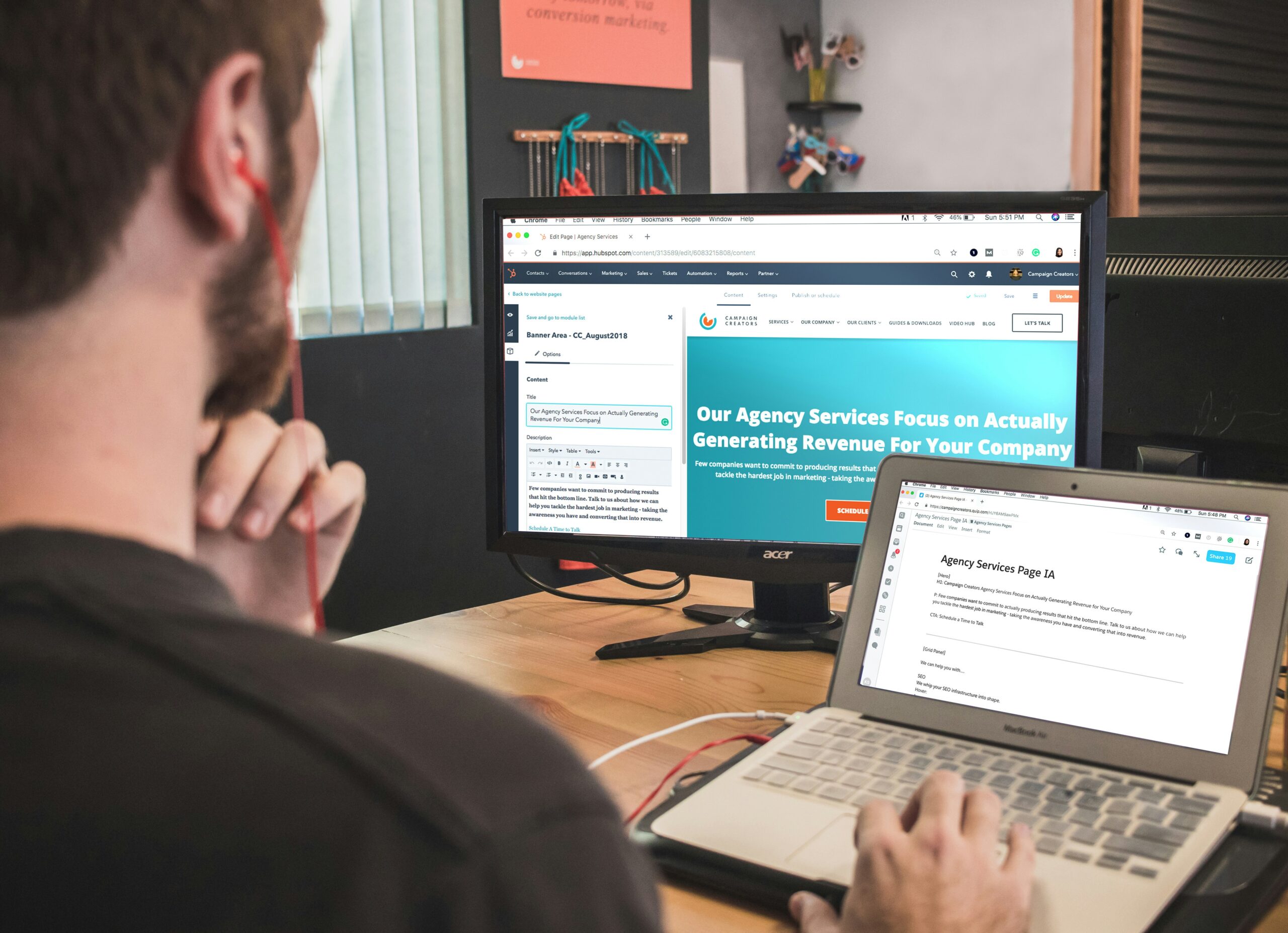Are you struggling to attract potential clients online? Many businesses find it difficult to generate leads in the digital space. This blog post explores effective strategies for online lead generation, highlighting key techniques like content marketing and SEO best practices. Readers will gain practical insights that can transform casual visitors into loyal customers, ultimately addressing the challenge of acquiring clients. Engaging with this content will equip entrepreneurs with the tools to boost their marketing efforts and ensure steady growth.
Key Takeaways
- Marketing automation streamlines communication and fosters trust with potential clients over time
- High-quality content attracts leads and showcases expertise while building credibility in the market
- Tailoring messaging based on audience feedback enhances marketing automation and lead generation efforts
- Engaging visuals and clear calls-to-action increase conversion rates on landing pages
- Segmenting email audiences allows for personalized outreach, improving engagement and conversion likelihood
Understanding Online Lead Generation Strategies

Online lead generation strategies hinge on understanding how potential clients engage with content. Marketing automation plays a critical role by streamlining communication across various touchpoints, ensuring that potential leads receive timely and relevant information. This approach fosters a relationship that encourages trust and engagement over time.
Content marketing remains a cornerstone of effective lead generation. By providing valuable resources such as blog posts, webinars, and infographics, businesses can draw in prospects who are actively seeking solutions to their challenges. This strategy not only showcases expertise but also builds credibility in the marketplace.
To maximize lead generation efforts, it is essential to analyze and refine strategies regularly. Tailoring messaging and content based on audience feedback and behavior can enhance marketing automation processes. By continuously optimizing these lead generation strategies, businesses can ensure a steady pipeline of qualified leads, paving the way for sustainable growth.
Content Marketing Techniques for Lead Generation
Crafting high-quality blog posts lays the foundation for an effective marketing strategy, helping to engage users and build trust. Utilizing video content captures attention and improves connections, while incorporating infographics enhances visual impact. Promoting content through guest blogging expands outreach, and creating compelling calls-to-action boosts engagement. These techniques collectively contribute to generating leads and enriching the database of potential clients.
Crafting High-Quality Blog Posts
Crafting high-quality blog posts is a vital technique for creators looking to generate leads effectively. By addressing the specific challenges faced by their target audience, brands can create informative content that resonates deeply with potential clients. Including tailored lead forms within these posts invites engaged readers to take a step further, bridging the gap between valuable information and actual conversions.
Utilizing Video Content to Engage Users
Video content serves as a powerful tool in engaging users by delivering messages in a dynamic, visually appealing format. It allows businesses to showcase their unique value proposition and connect with diverse demographics, effectively reaching potential clients who might prefer visual learning. By leveraging lead generation software to track video performance, companies can refine their messaging based on viewer behavior, ensuring that their content ranks well in search engines while generating meaningful leads.
Incorporating Infographics for Visual Impact
Incorporating infographics into web content can significantly enhance the lead generation process, especially for marketing campaigns aimed at retail. These visually engaging tools simplify complex information, making it easier for potential clients to grasp critical concepts quickly. By presenting data in an appealing format, businesses not only attract attention but also create an opportunity to generate leads online, guiding clients toward taking action.
Promoting Content Through Guest Blogging
Promoting content through guest blogging is an effective method to enhance visibility and build credibility within a specific industry. By writing informative articles for established sites, creators can reach broader audiences, guide readers through their marketing funnel, and highlight their expertise. Including links to valuable resources, such as newsletters or graphics, allows for seamless lead capture, ultimately turning casual visitors into qualified leads.
- Enhances visibility and builds credibility for content creators.
- Guides readers through the marketing funnel.
- Offers valuable resources like newsletters and graphics for effective lead capture.
Creating Compelling Calls-to-Action in Content
Creating compelling calls-to-action (CTAs) is a vital strategy in online marketing that directly impacts customer engagement and lead generation. A well-crafted CTA guides visitors on a lead generating website toward the next step, whether it’s signing up for a newsletter or downloading a resource. By using action-oriented language and highlighting the benefits of taking action, businesses can effectively transform casual visitors into engaged leads, enhancing their overall direct marketing efforts.
Designing High-Converting Landing Pages

Key elements shape an effective landing page, critical for any lead generation strategy. Optimizing forms increases conversion rates, while A/B testing helps identify the best-performing designs. Engaging visuals and compelling copy enhance user experience, and implementing exit-intent popups can capture potential leads before they leave. These strategies significantly boost return on investment in lead generation marketing, making them essential for success.
Elements of an Effective Landing Page
An effective landing page is vital for optimizing lead generation strategies. Key elements include well-designed lead capture forms, which should be simple and user-friendly to encourage potential clients to provide their information. Utilizing elements such as clear calls-to-action and visually engaging content can enhance user experience, further supported by integrating social media marketing and automation tools. By creating a space that guides users seamlessly, thought leaders can significantly improve conversion rates and foster meaningful connections with their audience.
Optimizing Forms for Better Conversion Rates
Optimizing lead generation forms is essential for enhancing conversion rates and generating leads effectively. By simplifying the information required, organizations can minimize friction, making it easier for potential clients to engage. Incorporating features like online chat can further assist visitors, providing immediate support and encouraging them to complete the form, ultimately leading to increased success in campaigns, including those driven by PPC ads.
A/B Testing Landing Page Variations
A/B testing landing page variations allows businesses to identify which elements resonate best with their audience. For instance, incorporating a chatbot can enhance user engagement and provide immediate assistance, leading to higher conversion rates. By testing different offers, such as access to free content, organizations can optimize their landing pages based on real-time feedback, similar to strategies highlighted by Forbes and The Wall Street Journal.
Using Engaging Visuals and Copy
Using engaging visuals and compelling copy is essential for optimizing landing pages aimed at lead generation. Attention-grabbing images, alongside clear and concise text, can effectively communicate the value of an offer, prompting visitors to take action. For example, when incorporating visuals that highlight benefits, businesses can appeal to potential clients in their mailing list, ultimately guiding them through the lead generation process with ease.
- Utilize attention-grabbing images to enhance engagement.
- Write clear and concise copy that communicates value effectively.
- Highlight benefits to appeal to potential clients on your mailing list.
- Guide visitors toward taking action in the lead generation process.
Implementing Exit-Intent Popups
Implementing exit-intent popups on landing pages can significantly enhance outbound lead generation efforts by addressing consumer needs before they leave the site. These popups, which appear just as a user attempts to navigate away, can offer valuable resources or discounts, helping reduce friction in the user experience. By incorporating such strategies above the fold, businesses not only capture attention but also improve their search engine optimization efforts by increasing engagement and conversion rates.
Leveraging SEO Best Practices for Lead Generation

Effective lead generation relies on several SEO practices to enhance visibility and attract targeted prospects. Conducting keyword research will enable marketers to identify high-value terms that align with audience behavior. Optimizing content for on-page SEO and building quality backlinks further supports this goal. Additionally, employing local SEO strategies helps capture location-based leads, while monitoring and analyzing SEO performance ensures ongoing improvement in the lead generation funnel.
Conducting Keyword Research for Targeted Leads
Conducting keyword research is vital for effective online lead generation, as it helps businesses understand their target market and tailor their content accordingly. By analyzing statistics related to search behavior, marketers can identify high-impact keywords that resonate with potential clients. This understanding not only enhances lead capture efforts in digital marketing but also allows businesses to position themselves as trusted sources of information, ultimately driving qualified leads into their funnels.
Optimizing Content for on-Page SEO
Optimizing content for on-page SEO is essential for attracting leads and improving customer experience. By clearly defining a strong value proposition within the content, businesses can connect with potential clients, addressing their pain points effectively. Additionally, incorporating strategically placed buttons with strong calls-to-action can guide users effortlessly toward desired actions, enhancing engagement and increasing conversion rates.
Building Quality Backlinks to Increase Visibility
Building quality backlinks is crucial for increasing visibility and enhancing lead generation efforts. When businesses engage in targeted advertising and develop strong relationships with reputable sites, they create opportunities for personalization and credibility. For instance, by offering an incentive such as valuable resources or exclusive content in exchange for backlinks, companies can drive more traffic, ultimately helping to generate leads and expand their audience effectively.
Using Local SEO Strategies for Location-Based Leads
Implementing local SEO strategies is essential for businesses seeking to attract location-based leads. By utilizing analytics to identify local search trends, companies can optimize their content effectively, targeting potential clients searching for relevant solutions nearby. Offering a compelling call to action along with valuable lead magnets, such as exclusive promotions or downloadable resources, encourages visitors to provide their email address, thereby enhancing the opportunity for meaningful engagement and future conversions.
Monitoring and Analyzing SEO Performance
Monitoring and analyzing SEO performance is essential for businesses aiming to enhance their lead generation efforts. By regularly assessing metrics such as organic traffic, keyword rankings, and user engagement, brands can adjust their copywriting to better resonate with their target audience. This process not only improves brand awareness but also helps in creating valuable resources like white papers that address specific customer needs and interests.
- Regularly assess metrics like organic traffic and keyword rankings.
- Adjust copywriting to resonate more effectively with the target audience.
- Create valuable resources, such as white papers, to address customer needs.
- Enhance brand awareness through continuous improvement in SEO strategy.
Implementing Email Marketing Campaigns
Building a robust email list with value-added incentives is the foundation of a successful email marketing strategy. Segmenting the audience allows for personalized outreach, ensuring messages resonate. Engaging email content and captivating subject lines drive opens and clicks. Automating email sequences enhances efficiency, while analyzing campaign metrics provides valuable insights to refine strategies. These elements are crucial for maximizing revenue in any lead generation campaign
Building an Email List With Value-Added Incentives
Building an email list with value-added incentives is crucial for effective online lead generation. By creating tailored offers that align with the target persona, businesses can attract subscribers through various channels, including social media and online advertising. For example, providing exclusive content or resources in exchange for email sign-ups not only boosts engagement but also helps to establish meaningful relationships with potential clients, ultimately enhancing future outreach efforts and generating valuable backlinks through shared customer connections.
Segmenting Your Audience for Personalized Outreach
Segmenting the audience is a critical aspect of lead generation that enables businesses to tailor their email marketing campaigns effectively. By identifying different customer segments, such as potential owners or individuals interested in customer service, companies can create personalized outreach that addresses specific needs and pain points. This targeted approach not only improves engagement but also increases the likelihood of converting leads into sales qualified leads, ultimately enhancing the overall success of lead generation efforts.
- Identify distinct audience segments like owners and customer service interested individuals.
- Create tailored messaging for each segment to address their specific needs.
- Increase engagement by personalizing outreach based on the segment’s interests.
- Improve chances of conversion into sales qualified leads.
Crafting Engaging Email Content and Subject Lines
Crafting engaging email content and subject lines is essential for effective online lead generation. Personalized messages that include offers like a coupon can entice readers to take action, while subject lines that promote referral marketing encourage recipients to share with their networks. This not only fosters a conversation around the brand but also enhances the overall outreach, allowing businesses to connect authentically with potential clients:
- Create personalized email messages that resonate with specific audience segments.
- Incorporate compelling offers, such as coupons, to drive immediate action.
- Utilize subject lines that highlight benefits and encourage sharing through referral marketing.
- Encourage open communication to foster a meaningful conversation with leads.
Automating Email Sequences for Efficiency
Automating email sequences is a key strategy for optimizing lead generation efforts. With the right automation tools, businesses can send targeted messages at the right moments, ensuring potential clients receive relevant content tailored to their interests. For instance, a series of welcome emails can nurture new subscribers and guide them through the initial stages of engagement effectively, helping to build a strong relationship from the start:
| Email Sequence Stage | Email Purpose | Example Content |
|---|---|---|
| Welcome Email | Introduce the brand and set expectations | “Thank you for subscribing! Here’s what you can expect from us…” |
| Value Email | Provide useful tips or resources | “Check out this guide on maximizing your productivity…” |
| Engagement Email | Encourage interaction or feedback | “We’d love to hear your thoughts! Reply to this email and let us know…” |
Analyzing Email Campaign Metrics for Improvement
Analyzing email campaign metrics is essential for refining strategies and boosting lead generation efforts. By closely monitoring key indicators such as open rates, click-through rates, and conversion rates, businesses can gain insights into what resonates with their audience. For instance, if a particular subject line consistently yields higher open rates, it serves as a clear signal to craft similar messaging in future campaigns, ultimately enhancing user engagement and supporting ongoing outreach initiatives.
Harnessing the Power of Social Media Platforms

Identifying the right social media platforms is crucial for reaching the target audience effectively. Sharing valuable content attracts leads while running targeted ad campaigns can enhance visibility. Engaging with followers builds community and trust, complemented by showcasing social proof and testimonials to reinforce credibility. Each approach plays a vital role in the lead generation process, setting the stage for deeper exploration in the following sections.
Identifying the Right Platforms for Your Audience
Identifying the right social media platforms is essential for effectively reaching potential clients. Each platform has distinct audiences and engagement styles, so understanding where target demographics spend their time can significantly enhance lead generation efforts. For instance, B2B businesses may find LinkedIn most effective for connecting with professionals, while brands targeting younger consumers might focus on Instagram and TikTok to reach a broader audience with engaging content.
Sharing Valuable Content to Attract Leads
Sharing valuable content on social media is a strategic approach to attract leads by providing potential clients with resources that address their needs and interests. Posts that include informative articles, how-to guides, and engaging videos can position brands as helpful sources, establishing trust and credibility. For example, when a consultant shares insights or tips relevant to industry challenges, it not only showcases their expertise but also entices viewers to engage further, whether through questions or by seeking additional resources:
| Content Type | Purpose | Example |
|---|---|---|
| Informative Articles | Provide insights and solutions | “10 Tips for Effective Marketing Automation” |
| How-To Guides | Offer step-by-step solutions | “How to Set Up Your First Email Campaign” |
| Engaging Videos | Visual storytelling to connect | “Webinar on Building Trust with Clients” |
Running Targeted Ad Campaigns
Running targeted ad campaigns on social media is a powerful method for businesses to reach specific audiences effectively. By utilizing audience segmentation tools available on platforms like Facebook and Instagram, marketers can tailor their ads based on demographics, interests, and behaviors, leading to higher conversion rates. For instance, a consultant specializing in marketing automation can create ads highlighting their expertise while targeting individuals in industries that benefit from their services, thus ensuring that the message resonates with potential clients actively seeking solutions.
Engaging With Followers and Building Community
Engaging with followers on social media is essential for building a strong community and enhancing lead generation efforts. By actively responding to comments, sharing user-generated content, and initiating conversations, businesses can demonstrate their commitment to audience needs. This interaction not only fosters trust but also encourages followers to share content, ultimately expanding reach and attracting new leads.
Essential elements that contribute to effective engagement include:
| Engagement Strategy | Description | Example |
|---|---|---|
| Active Response | Responding promptly to comments and messages | Thanking a follower for their feedback on a post |
| User-Generated Content | Sharing content created by followers | Highlighting a customer’s success story related to your service |
| Conversation Starters | Asking questions to encourage discussion | “What challenges are you facing with your marketing strategies?” |
Using Social Proof and Testimonials
Utilizing social proof and testimonials is a powerful method in online lead generation. When potential clients see positive feedback from satisfied customers, it builds trust and validates the quality of services offered. For instance, sharing success stories on social media platforms can demonstrate real-life impacts and encourage prospects to engage, as they feel more confident in choosing a business that others have already benefited from. This strategy not only enhances credibility but also addresses the common concern of uncertainty among leads, nudging them closer to making a decision.
Utilizing Webinars for Lead Generation

Selecting engaging topics is crucial for capturing the interest of the target audience during webinars. Promoting the event effectively ensures that the right attendees join, while interacting with participants during the session fosters meaningful engagement. Following up post-webinar helps maintain connections, and repurposing content offers lasting value. Each of these strategies contributes significantly to maximizing lead generation through webinars.
Selecting Engaging Topics for Your Audience
Selecting engaging topics for webinars can significantly enhance lead generation efforts. To attract the right audience, it’s important to focus on subjects that address specific challenges faced by potential clients. For instance, a marketing automation consultant may choose to host a webinar on “Streamlining Your Sales Funnel,” which not only showcases their expertise but also delivers actionable insights. Identifying and addressing audience pain points will foster deeper connections, allowing participants to see the value in the offered solutions:
- Focus on challenges faced by the target audience.
- Showcase expertise through relevant topics.
- Deliver actionable insights to enhance engagement.
Promoting Your Webinar Effectively
Promoting a webinar effectively is essential for attracting a relevant audience and maximizing lead generation. Utilizing channels like social media, email newsletters, and even personal networks can significantly enhance visibility. Creating a sense of urgency with limited spots or exclusive content for attendees can motivate potential clients to register, providing them with valuable insights that address their specific needs:
| Promotion Method | Description | Example |
|---|---|---|
| Social Media Posts | Share engaging graphics and snippets to capture attention. | Post a short video teaser on LinkedIn to promote the webinar. |
| Email Campaigns | Send invitations highlighting key topics and benefits of attending. | Include a personalized email invite to targeted segments of the list. |
| Personal Outreach | Reach out personally to contacts who may benefit from the content. | Message key clients directly about the topics covered. |
Interacting With Attendees During the Session
Interacting with attendees during a webinar is crucial for establishing engagement and building trust. By utilizing features such as live chat, polls, and Q&A sessions, presenters can encourage real-time participation, allowing attendees to express their thoughts and ask pertinent questions. This two-way communication not only keeps potential clients invested but also provides valuable insights into their needs and challenges, which can inform future content and lead generation strategies.
Following Up With Attendees Post-Webinar
Following up with attendees post-webinar is essential for sustaining interest and nurturing potential leads. Businesses can send personalized thank-you emails that not only express gratitude but also share additional resources related to the topics discussed, reinforcing their value as a knowledgeable resource. This follow-up engagement helps maintain the connection, guiding attendees toward further actions such as subscribing to newsletters or booking consultations, effectively moving them closer to becoming clients.
| Follow-Up Strategy | Description | Example |
|---|---|---|
| Thank-You Email | Express gratitude and create a positive impression | Send a message thanking attendees for joining, with links to additional resources. |
| Resource Sharing | Provide valuable content related to the webinar topics | Include links to relevant articles, eBooks, or videos. |
| Call to Action | Encourage the next steps for further engagement | Invite attendees to schedule a consultation to discuss their needs. |
Repurposing Webinar Content for Future Use
Repurposing webinar content presents an opportunity to extend the lifespan of valuable insights while attracting a broader audience. For instance, turning recorded sessions into blog posts, short clips, or downloadable guides allows businesses to reach individuals who may not attend the live event. This strategy not only enhances lead generation efforts by continually supplying fresh, relevant material but also establishes the brand as a reliable source of expertise, fostering trust with potential clients.
Exploring Pay-Per-Click Advertising Options
Setting up effective PPC campaigns involves choosing the right keywords for ads, creating compelling ad copy that converts, and closely monitoring campaign performance. By implementing targeted retargeting strategies, businesses can further boost lead conversion rates. Each of these elements plays a critical role in optimizing online lead generation efforts and ensuring maximum return on investment.
Setting Up Effective PPC Campaigns
Setting up effective PPC campaigns requires careful selection of keywords that align with potential clients’ search intent, which is crucial for attracting the right audience. By creating compelling ad copy that clearly communicates the unique value of the offered services, businesses can enhance their click-through rates and encourage meaningful engagement. Continuous monitoring of campaign performance allows for real-time adjustments, optimizing ads to improve lead generation results and ensure a strong return on investment.
Choosing the Right Keywords for Your Ads
Choosing the right keywords for online ads is essential for attracting qualified leads. Marketers should focus on terms that align with the actual questions and needs of potential clients. For instance, a consultant specializing in marketing automation might target phrases like “automate customer acquisition” or “effective sales funnels” to ensure their ads reach those actively searching for these solutions. By integrating these specific keywords into their PPC campaigns, businesses can see improved click-through rates, ultimately generating a higher volume of relevant leads.
Creating Compelling Ad Copy That Converts
Creating compelling ad copy that converts is essential for effective pay-per-click advertising strategies. Marketers should focus on clear and persuasive language that highlights the benefits of their services, addressing potential clients’ needs directly. For example, instead of a generic statement, using phrases like “Transform your sales process today” can motivate clicks, leading users to engage further with the brand.
Monitoring and Adjusting Campaign Performance
Monitoring and adjusting campaign performance is essential for optimizing pay-per-click (PPC) advertising efforts. By analyzing metrics such as click-through rates, conversion rates, and cost per acquisition, businesses can gain insights into what works and what doesn’t. This data allows marketers to make informed decisions, refining keyword choices and ad copy to better align with target audiences’ needs and behaviors.
| Metric | Description | Actionable Insight |
|---|---|---|
| Click-Through Rate (CTR) | Percentage of users who clicked on the ad after seeing it | Improve ad copy or targeting if CTR is low |
| Conversion Rate | Percentage of users who took the desired action after clicking | Test different landing pages or offers |
| Cost Per Acquisition (CPA) | Total cost of acquiring a new customer | Adjust bids or optimize ads to reduce CPA |
Retargeting Strategies to Boost Lead Conversion
Retargeting strategies play a crucial role in enhancing lead conversion rates within PPC advertising campaigns. By displaying targeted ads to users who have previously engaged with a brand but did not convert, businesses can remind potential clients of their offerings and encourage them to return. Utilizing retargeting can significantly improve conversion rates by serving tailored messages based on users’ past interactions, such as viewing specific products or signing up for newsletters, thus addressing their unique needs and facilitating the next steps towards conversion:
- Display targeted ads to engage previous website visitors.
- Utilize ad messaging based on prior interactions.
- Encourage return visits for higher chances of conversion.
Analyzing and Measuring Lead Generation Success

Defining key performance indicators (KPIs) is essential for measuring lead generation success. Using analytics tools provides valuable insights into performance data, allowing for adjustments to strategies as needed. Setting clear goals and benchmarks drives improvement, while continuous learning ensures adaptability in an ever-changing landscape. These focused approaches enhance effective online lead generation efforts and improve overall results.
Defining Key Performance Indicators
Defining key performance indicators (KPIs) is essential for measuring success in online lead generation efforts. By focusing on metrics such as conversion rates, click-through rates, and customer acquisition costs, businesses can gain valuable insights into which strategies are effective and which need refinement. For instance, tracking the conversion rate of landing pages can help identify what resonates with potential clients, ultimately guiding adjustments to improve engagement and increase leads.
Using Analytics Tools for Data Insights
Utilizing analytics tools is essential for gaining valuable insights into lead generation effectiveness. By tracking key metrics such as conversion rates and customer behavior, businesses can identify which strategies resonate most with their target audience. For instance, marking changes in user engagement after implementing specific campaigns provides clear data that can guide future marketing decisions, ensuring that efforts are aligned with audience preferences and ultimately driving better results.
Adjusting Strategies Based on Performance Data
Adjusting strategies based on performance data is vital for businesses aiming to optimize their online lead generation efforts. By analyzing data such as conversion rates, click-through rates, and user engagement, companies can identify what resonates with their audience and what requires improvement. For instance, if a particular call-to-action is underperforming, testing different wording or placements can lead to a significant increase in engagement and conversions:
- Identify key performance indicators (KPIs) relevant to lead generation.
- Utilize analytics tools to track user behavior and engagement.
- Make informed adjustments to strategies based on performance insights.
- Test different approaches, such as modifying copy or layout, to improve results.
Setting Goals and Benchmarks for Improvement
Setting clear goals and benchmarks is essential for measuring success in online lead generation efforts. By defining specific, measurable objectives—such as increasing conversion rates by a certain percentage within a set timeframe—businesses can gauge their progress and make informed adjustments. For instance, a marketing automation consultant may track the number of qualified leads generated from a recent campaign, which helps pinpoint areas for improvement and refine future strategies aimed at attracting their target audience.
Continuous Learning and Adaptation
Continuous learning and adaptation are essential components for businesses aiming to excel in online lead generation. By staying updated with industry trends and analyzing the performance of their marketing strategies, organizations can fine-tune their approaches to meet evolving audience needs. For instance, utilizing data from past campaigns can guide adjustments in messaging or targeting, ensuring that outreach efforts remain relevant and effective in converting leads into loyal clients:
| Key Focus Area | Action Steps | Expected Outcome |
|---|---|---|
| Identify industry trends | Regularly review reports and articles | Stay ahead of the competition |
| Analyze campaign performance | Utilize analytics tools to assess results | Enhance future marketing strategies |
| Adjust messaging and targeting | Refine outreach based on data insights | Increase conversion rates and lead quality |
Conclusion
Effective strategies for online lead generation are vital for businesses aiming to attract and engage potential clients. By leveraging marketing automation, creating high-quality content, and optimizing landing pages, brands can build trust and convert casual visitors into loyal customers. Regular analysis and adaptation of these strategies ensure sustained growth and improved engagement. Prioritizing these tactics positions businesses as authoritative resources, driving meaningful connections in an increasingly competitive marketplace.






